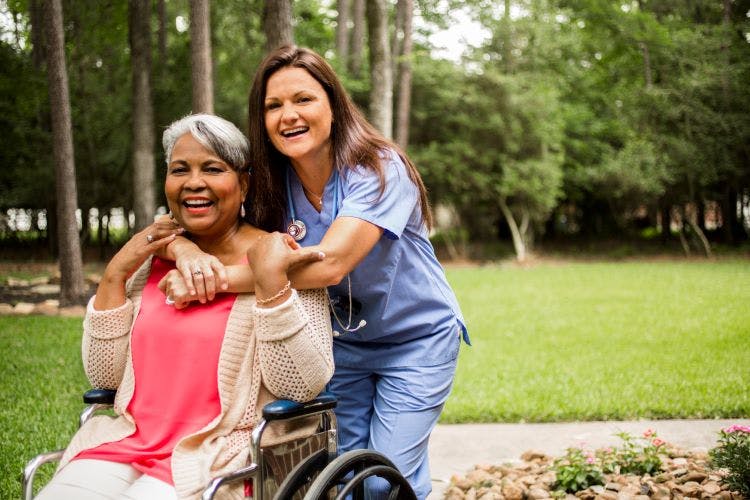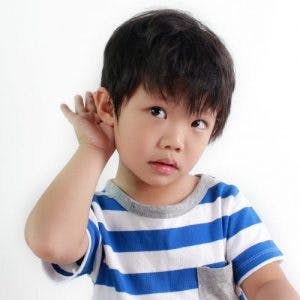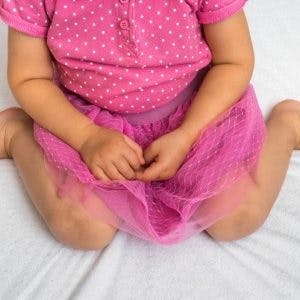Cerebral palsy is a group of movement disorders caused by damage to the developing brain. Although the damage to the brain does not worsen or improve over time, the signs and symptoms of cerebral palsy may change or worsen as individuals age. Fortunately, the right intervention can improve many symptoms of cerebral palsy.
This guide will explore the various signs and symptoms of cerebral palsy at various stages of a person’s life. Please use the links below to jump straight to any section of this article.
Signs and symptoms of cerebral palsy in:
Signs of Cerebral Palsy in Infants
Cerebral palsy is a condition that starts early in life as it is caused by damage to the brain before, during, or shortly after birth. Because of the early onset, it might seem like infants should show obvious signs if they have cerebral palsy or not. However, since cerebral palsy presents itself outwardly through motor impairments, it can be challenging to diagnose it in infants under age 1.
The motor skills of infants are still developing and changing rapidly. Therefore, it’s hard to spot motor impairments like poor fine motor skills or abnormal walking patterns in infants, even though they’re easier to recognize in adults. Furthermore, when the signs and symptoms of cerebral palsy are mild, diagnosing cerebral palsy in infants is even harder.
With this in mind, there are some common signs of cerebral palsy in infants:
Developmental Delays
Possibly the most common sign of cerebral palsy in infants is developmental delays. There are specific developmental milestones that infants achieve as they grow. All infants progress at their own pace, however infants with cerebral palsy often may not progress toward major developmental milestones as quickly as expected.
Examples of developmental milestones include:
- 2 months: able to lift their head, move arms and legs evenly
- 4 months: able to reach for and grasp objects, sit upright with assistance, roll over
- 6 months: able to sit up independently, babble, use both hands to handle objects
- 9 months: able to crawl, pull up to stand, use a pincer grip, purposefully engage with toys
- 1 year: able to stand and sit down independently, point to objects, may be walking or using simple words.
Children may fall behind in meeting these milestones regardless of whether or not they have cerebral palsy. It is important to check with your doctor if you feel that your infant is not progressing as they should. However, doctors can be hesitant to officially diagnose milder cases of cerebral palsy at such an early age as infants often “grow out” of cerebral palsy-like symptoms by age 2.
Irregular Muscle Tone
Another sign of cerebral palsy in infants is abnormally high or low muscle tone. High muscle tone (spasticity) results in stiff movements and is characteristic of the most common type of CP, called spastic cerebral palsy. Infants with spasticity may demonstrate prolonged hand clenching, leg crossing, or bent knees.
On the other hand, those with low muscle tone (hypotonia) can be identified by lack of strength, floppy limbs, and inadequate head control. Generally, infants with only low muscle tone have ataxic cerebral palsy.
Infants with dyskinetic cerebral palsy will experience uncontrollable fluctuations between both high and low muscle tone, which can make it appear as if they are always moving.
Tremors
Although not as common, if you notice your infant’s arm starts shaking as they reach for objects, they may have ataxic cerebral palsy. This type of cerebral palsy causes a lack of balance and coordination. Purposeful movements can overwhelm the cerebellum (which is responsible for fine-tuning and precision) and cause tremors.
Poor feeding
Cerebral palsy can affect all different parts of the body, including the muscles in the mouth. If your child doesn’t seem to eat very much, it may be a sign of an oral motor impairment. This can make it difficult for your child to open or close the mouth and swallow. You can generally identify feeding difficulties easily and should report them to a doctor quickly to prevent malnutrition.
Although it may be challenging to find out that your infant has cerebral palsy, early diagnosis is ideal for promoting optimal motor development. The brains of infants experience high levels of neuroplasticity, or their ability to adapt and rewire themselves to learn and improve skills. Taking advantage of early intervention therapies during a child’s first year can help your infant continue progressing toward appropriate developmental milestones and minimize or even prevent future complications.
Signs of Cerebral Palsy in Toddlers

Since toddlers are typically further along in their development of motor skills, it is often easier to identify signs of cerebral palsy in toddlers. In fact, while most cases of cerebral palsy are diagnosed by the time the child reaches 1 or 2 years old, milder cases of cerebral palsy may not be diagnosed until the child is 4 or 5.
There are similar signs and symptoms of cerebral palsy in toddlers and infants such as slower progression toward developmental milestones, irregular muscle tone and poor feeding. However, some signs of cerebral palsy appear in toddlers but not in infants. Let’s take a look at a few of these examples.
Abnormal Gait
In toddlers with cerebral palsy, uneven muscle pull can result in abnormal walking patterns, including consistent tiptoeing, crouch gait, and scissor gait. Toddlers with cerebral palsy who struggle with balance may continue to walk with their feet spread far apart because it creates a more stable base and will prevent them from falling. These atypical walking patterns may be signs of cerebral palsy.
Speech Difficulties
By 2 years old, your toddler should be piecing words together. If you notice significantly delayed responses, poor pronunciation, stuttering, or jumbled speech, your toddler may have difficulties controlling the muscles in their mouth.
Also related to oral motor impairments are breathing difficulties. If your toddler struggles to breathe in between words or has nasally speech, this may also be a sign of cerebral palsy.
Poor Coordination
If your toddler has difficulties with fine motor tasks, such as grabbing and picking up small objects, using silverware, or holding up a pencil, they may have ataxic cerebral palsy. This type of cerebral palsy causes poor balance and coordination.
Although the above signs do not “prove” that your toddler has cerebral palsy, they may be causes for concern. Discuss any motor impairments you notice with your toddler’s pediatrician.
While toddlers have had some time to develop poor movement patterns and habits, they still can benefit from early intervention methods to minimize the effects of cerebral palsy on their development and promote optimal functional abilities.
Cerebral Palsy Symptoms in Adults
Not unlike the signs of cerebral palsy in infants and toddlers, cerebral palsy symptoms in adults include irregular muscle tone, abnormal walking patterns, and poor balance and coordination. However, adults are unique in that they have had many years to either focus on managing their cerebral palsy symptoms, or allowing these symptoms to progress.
Adults who have been actively managing their cerebral palsy symptoms may still experience irregular muscle tone and difficulties with coordination. However, they may have improved their gait patterns, and addressed communication and feeding difficulties through compensatory techniques.
Adults with milder cases of cerebral palsy are often able to live fully independent lives by appropriately managing their symptoms. Even those with more severe cases can limit the progression of their symptoms and prevent complications through active management techniques.
Passively “living with” cerebral palsy symptoms may result in increased symptom severity over time. Although the brain damage that caused cerebral palsy in early life does not change, the associated motor impairments may worsen if not addressed. Therefore, some adults with cerebral palsy may have more spasticity or develop further complications, such as chronic pain, fatigue, joint contractures, and incontinence.
While the signs and symptoms of cerebral palsy change with age, they also vary greatly depending on the type of cerebral palsy. There are four main types of cerebral palsy: spastic, dyskinetic, ataxic and mixed.
Spastic Cerebral Palsy Symptoms
The vast majority of individuals with cerebral palsy experience spastic CP. As its name suggests, this type of CP is characterized by spasticity, which involves stiffness in the affected muscles. Anywhere from one limb to the entire body may be affected.
Other common spastic cerebral palsy symptoms include:
- Stiff, slow, or rigid movements
- Abnormal gait patterns
- Difficulties with balance
- Chronic pain
- Clenching of the fingers or toes
- Chewing, swallowing, or speaking difficulties
Since spastic cerebral palsy varies in severity and in which areas of the body it affects, it can present itself very differently in each individual.
Signs and Symptoms of Other Types of Cerebral Palsy
Dyskinetic, ataxic, and mixed cerebral palsy make up only about 20% of cerebral palsy cases.
Dyskinetic CP is distinguished from the other types of CP by its uncontrollable movements. Some movements are characterized by repetitive, twisting motions and abnormal postures (a condition called dystonia), while other movements are rapid and jerky due to fluctuating muscle tone (a condition called choreoathetosis).
Difficulties with balance and coordination are the main symptoms associated with ataxic cerebral palsy. Individuals with this type of CP often have low muscle tone, limited fine motor skills, speech difficulties, and poor posture. Due to difficulties with balance, they may walk with a wide-based gait and experience frequent falls.
Mixed cerebral palsy involves a combination of any of the above types of CP. Although symptoms of mixed CP may vary depending on the areas of brain damage involved, it most often presents as a combination of spastic and dyskinetic CP.
Understanding Signs and Symptoms of Cerebral Palsy: Key Points
Cerebral palsy can result in many different signs and symptoms throughout one’s lifetime. While it can be difficult to see signs and symptoms of CP in infants, they begin to become more prominent in toddlers. Depending on how dedicated individuals are to managing their symptoms, adults may have similar symptoms to those experienced in childhood or they may have improved.
It is important to remember that regardless of the type or severity of CP, you can always work on improving and managing your symptoms at any age for a better quality of life.











